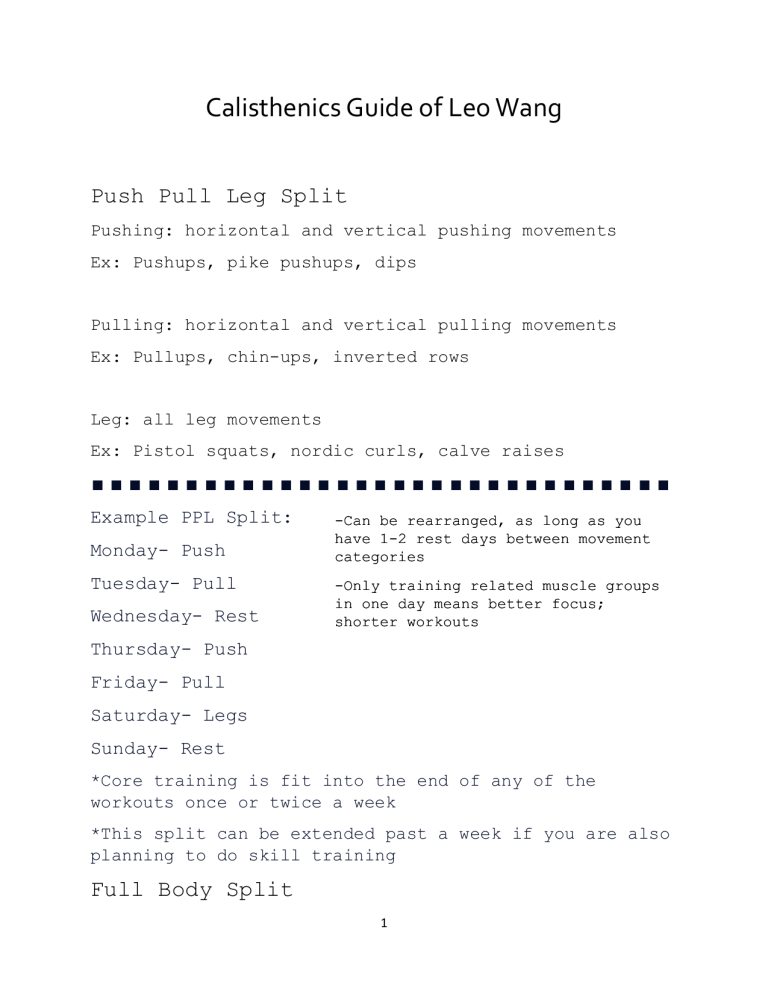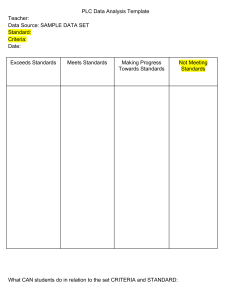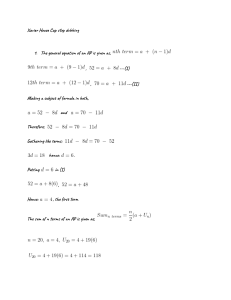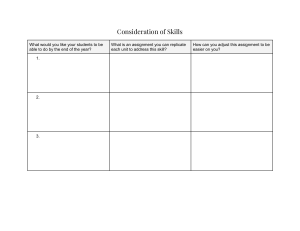
Calisthenics Guide of Leo Wang Push Pull Leg Split Pushing: horizontal and vertical pushing movements Ex: Pushups, pike pushups, dips Pulling: horizontal and vertical pulling movements Ex: Pullups, chin-ups, inverted rows Leg: all leg movements Ex: Pistol squats, nordic curls, calve raises ∎∎∎∎∎∎∎∎∎∎∎∎∎∎∎∎∎∎∎∎∎∎∎∎∎∎∎∎∎∎∎ Example PPL Split: Monday- Push Tuesday- Pull Wednesday- Rest -Can be rearranged, as long as you have 1-2 rest days between movement categories -Only training related muscle groups in one day means better focus; shorter workouts Thursday- Push Friday- Pull Saturday- Legs Sunday- Rest *Core training is fit into the end of any of the workouts once or twice a week *This split can be extended past a week if you are also planning to do skill training Full Body Split 1 -Meant for those who don’t have a lot of time -Full body workout including all categories of movement discussed in the video Ex: horizontal pushing/pulling, vertical pushing/pulling, core, legs -2-3 workouts a week -Less workouts throughout the week -High number of sets every workout, may cause you to fatigue mid workout and use less effort for remaining sets -May take a while to become accustomed to full body soreness Skill Split -Also referred to as periodization -Different cycles which last 4-6 weeks each where you train different aspects of a skill -Varying cycles for hypertrophy and skill specificity -Deloads at the end of each cycle 2 Training Styles *Intensity- how heavy or difficult an exercise is Strength Training: *Volume- amount of work you do (reps x sets) -Training for pure strength -high intensity with less reps per set and longer rest times (1-5 reps per set, 3–5-minute rest per set) Hypertrophy Training: -Training to build muscle efficiently/ increase muscular endurance -Higher volume, short rest times (8-12 reps per sets, 1-3 minutes rest per set) *Both styles of training will promote muscle growth but training purely for hypertrophy will not help you gain strength efficiently in calisthenics ∎∎∎∎∎∎∎∎∎∎∎∎∎∎∎∎∎∎∎∎∎∎∎∎∎∎∎∎∎∎∎ -Beginners should have a mix of both hypertrophy training and strength training in their routine -Create a routine with exercises of varying difficulty and utilize different rep ranges and rest times 3 Routine Building -If you plan to build your own workout routine make sure each workout has all categories of movement corresponding to whether it is a push, pull, or leg workout Ex: -Push workouts should include: Vertical pushing in both directions, horizontal pushing -Pull workouts should include: Vertical and horizontal pulling -Leg workouts should include: Piston squat progression, nordic curl/ hamstring curl progression, and calve raises if you are training them for calisthenics -Core workouts can be fit into the end of any push pull or leg work once or twice a week and should include: leg raise progression, seated pike lift progression, hollow body hold progression 4 Exercise List (Push) Vertical pushing (overhead) -Pike pushup (adjust difficulty with hand placement) -Decline pike pushup (adjust difficulty with hand placement and decline height -Decline pike pushup with parallettes/elevated hands (adjust difficulty with hand placement, decline height, parallettes height Vertical push (downwards) -Dip negatives (adjust difficulty with speed) -Dip with bands (adjust difficulty with band) Horizontal push -Incline knee pushups (adjust difficulty with incline height) -Knee pushups -Incline pushups (adjust difficulty with incline height) -Standard pushups 5 -Explosive pushups -Diamond/Archer push ups -Pseudo planchet pushups (adjust difficulty with lean) -Decline pushup variants Exercise List (Pull) Vertical pull Pull up negative (adjust difficulty with speed) Banded pull ups (adjust difficulty with band thickness) Pullup/Chin-up/Neutral Explosive pullup/chin-up/neutral Horizontal pull Inverted row with bent legs (adjust difficulty with bar/ring height) Inverted row with straight legs (adjust difficulty with bar/ring height) Inverted row with elevated legs (adjust difficulty with elevation height) Accessory work (difficulty dependent on person) 6 Accessory work (difficulty dependent on weaknesses) Isometric holds in your hardest rom Vertical scapula retraction and depression holds/pulls Horizontal scapula retraction and depression holds/pulls Exercise List (Legs) Pistol squats -Single leg box step -Pistol squat with hand assistance -Pistol squat with opposing leg not locked -Elevated pistol squat -Standard pistol squat Nordic curls -Nordic curl negative with posterior pelvic tilt (adjust difficulty with tilt angle) 7 -Nordic curl negative with posterior pelvic tilt and pushup (adjust difficulty with tilt angle, and pushup power) -Nordic curl negative with pushup (adjust difficulty with pushup power) -Standard nordic curl Sliding hamstring curls -Sliding curl with posterior pelvic tilt (adjust difficulty with tilt angle) -Standard sliding curl -Sliding curl with one leg Calve raises -Calve raises with both legs (adjust difficulty by elevation) -Single leg calve raises (adjust difficulty by elevation) Exercise List (Core) Leg raises -Knee raises -Knee raises with one leg extended -Knee raises extend both legs at top -Standard leg raises Hollow body hold 8 -Hollow body hold with hands on the side (adjust difficulty with leg leverage) -Hollow body hold with hands overhead -Hollow body hold with arm circles Seated pike lifts -Pike lift with backward lean and one leg (adjust difficulty with hand position) -Pike lift with one leg (adjust difficulty with hand position) -Pike lift with both legs (adjust difficulty with hand position) Accessory work (difficulty dependent on weaknesses) -Knee/leg raise holds -Pike lift holds -Hamstring stretches Beginner Template (1/4) Push Day 2 x 3-5 challenging pike pushup progression (3-5 minutes rest between sets) 9 Start each category of movement with a high intensity progression 3 x 5-8 pike push progression Less intense progression with more reps per set (1-3 minutes rest between sets) 2 x 3-5 challenging dip progression 3 x 5-8 dip progression 2 x 3-5 challenging horizontal pushing progression 3 x 5-8 horizontal pushing progression 2-3 sets of isometric holds/ accessory work is needed *Before any workout always properly stretch and warmup *The number shown represents the sets and reps. Ex: 2 x 3 means 2 sets of 3 reps Beginner Template (2/4) 10 Pull Day 2 x 3-5 challenging vertical pull progression 3 x 5-8 vertical pull progression 2 x 3-5 challenging horizontal pull progression 3 x 5-8 vertical pull progression 2-3 sets of isometric holds/ accessory work is needed *Before any workout always properly stretch and warmup *The number shown represents the sets and reps. Ex: 2 x 3 means 2 sets of 3 reps 11 Beginner Template (3/4) Leg Day 2 x 3-5 challenging pistol squat progression 3 x 5-8 pistol squat progression 2 x 3-5 challenging nordic curl/sliding curl progression 3 x 5-8 nordic curl/sliding curl progression 3 x max calve raise progression to failure 2-3 sets of isometric holds/ accessory work is needed *Before any workout always properly stretch and warmup *The number shown represents the sets and reps. Ex: 2 x 3 means 2 sets of 3 reps 12 Beginner Template (4/4) Core Workout 2 x 3-5 challenging seated pike lift progression 3 x 5-8 seated pike lift progression 2 x 3-5 challenging leg raise progression 3 x 5-8 leg raise progression 3 x max hallow body hold progression 2-3 sets of isometric holds/ accessory work is needed *Before any workout always properly stretch and warmup *The number shown represents the sets and reps. Ex: 2 x 3 means 2 sets of 3 reps 13 Beginner Templated Explained Starting with higher intensity exercises More energy and strength Push harder compared to if you did them after the higher volume sets Follow up the strength sets with higher volume sets to stimulate hypertrophy Finish with accessory work to help fix imbalances, improve specific weaknesses 14 Progressive Overload -Prevents plateaus strength and muscle gain -Progressively overload in calisthenics by increasing the difficulty of the exercises and/or increasing the rep ranges -A simple way to overload as a beginner is to reach 10-12 reps of exercise and then replace it with a harder progression -By keeping the same exercises with the same reps for a long period of time you may face with muscle gain breakdown -Make sure to eat healthy foods and fats that includes protein and carbohydrates to progress faster 15 Progressive Overload Example Push Day 2 x 3-5 challenging pike pushup progression 3 x 5-8 previously challenging pike pushup progression 2 x 3-5 challenging dip progression 3 x 5-8 dip progression 2 x 3-5 challenging horizontal pushing progression 3 x 5-8 horizontal pushing progression 2-3 sets of isometric holds/ accessory work are needed 16



